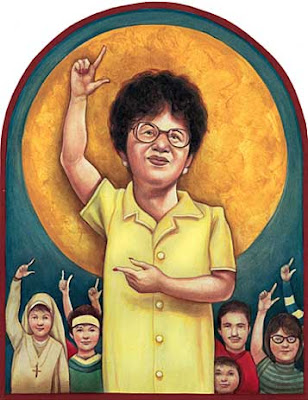
Welcome to Marlinspike Hall, ancestral home of the Haddock Clan, the creation of Belgian cartoonist Hergé. Some Manor-keeping notes: Navigation is on the right, with an explanation of the blog's fictional basis. HINT: Please read the column labelled "ABOUT THIS BLOG." Enjoy the most recent posts or browse posts by posting date in the Archives. Search the blog for scintillating, obscure topics. Enjoy your stay! There are some fuzzy slippers over there somewhere, too.
Friday, July 31, 2009
Corazon Aquino

More On Ketamine (Courtesy of the StudMuffin)
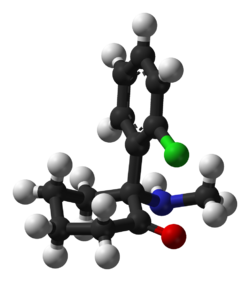 Courtesy of Jim Broatch, the StudMuffin of RSDSA (Reflex Sympathetic Dystrophy Syndrome Association -- an organization in need of a new name, if ever there was one...). Jim and His Fellow StudMuffins at RSDSA do phenomenal work for those mired in suffering now, all the while keeping their heads above water, their eyes on the prize of future therapies and happenin' research.
Courtesy of Jim Broatch, the StudMuffin of RSDSA (Reflex Sympathetic Dystrophy Syndrome Association -- an organization in need of a new name, if ever there was one...). Jim and His Fellow StudMuffins at RSDSA do phenomenal work for those mired in suffering now, all the while keeping their heads above water, their eyes on the prize of future therapies and happenin' research.In fact, kiddos, the real "read" here is not this pitiful little article from People magazine (I mean, the magazine's editors *would* look at the most extreme and ill-afforded "therapy" out there -- forget the hundreds of thousands who have no access to it, or who don't believe in its claims, or who are just too far gone into misery... and co-morbidity. I rhymed!) -- no, the real read is in this link that Jim Broatch also provides, which is to legitimate information to help you make up your mind about the ketamine angle based on solid stuff.
*** *** *** *** *** *** *** ***
After years of excruciating pain that drove him to thoughts of suicide, John Roach decided to gamble on a controversial new treatment-a ketamine-induced coma.
August 10, 2009
By Alicia Dennis
PEOPLE Magazine
John Roach looks up at wife Rosemary from his bed in room 133 at the Hospital San Jose in Monterrey, Mexico. "Don’t say goodbye," he pleads as doctors prepare to send the burly grandfather form Allentown, Pa., into unconsciousness. "It’s okay," Rosemary says. "Pleasant dreams."
Soon, deep in a coma, John descends into a frightening, topsy-turvy world. Scene: He’s in a strange house with paintings on the ceiling. Scene: He’s watching as his cat rushes into the path of an oncoming car. Scene: He’s a World War II soldier fighting on a blood-soaked battlefield. "It was weird and frightening," John recalls of his voluntary, five-day ordeal in late May. "But I needed to do something."
Suffering from a debilitating neuromuscular disorder called reflex sympathetic dystrophy (RSD) , John, 50, is one of about 100 chronic-pain patients resorting to a radical new treatment in search of relief-medically induced coma using ketamine, a surgical anesthetic and hallucinogen sold illegally as "Special K." advocates say ketamine comas can be a godsend for some. "We're giving people in excruciating pain a normal life," says Dr. Robert J. Schwartzman, neurology chairman at Philadelphia's Drexel University College of Medicine; since coma therapy isn't FDA approved, he's sent more than 60 patients to Germany and Mexico. But other experts say the treatment, which costs as much as $ 50,000 with travel, is too risky. "Vulnerable people are getting something expensive and potentially dangerous," says Dr. Norman Harden of the Rehabilitation Institute of Chicago.
Some 200,000 people suffer from RSD, in which ordinary pain escalates to crippling levels. "Think of holding a blowtorch to your skin," says John, whose entire left side was affected after he fell down rotted stairs and tore his rotator cuff in 2002. Because ketamine blocks pain receptors, Schwartzman says, very high doses can restart the nervous system, "like rebooting a computer."
Brandy Sachs, 23, of Christianburg, Va., had spent seven years in a wheelchair after a finger injury and ankle sprain spiraled into all-over agony. "I was giving her pain meds in doses that would have killed a horse," says her family doctor, Jeremy Freeman. Last fall, after undergoing a five-day coma in Germany, Brandy needed months of therapy to relearn how to walk, talk and eat. But now, she says, she's pain-free and plans to start her master's degree: "It's a miracle."
Not always. In October 2008, RSD patient and mother of three Laura Beckett, 47, of Magnolia, N.J., developed pneumonia while in a coma in Germany and was kept under for three weeks as doctors fought to save her. She woke up paralyzed from the neck down and now lives at a rehabilitation center. "It's an understatement to say things went wrong," says husband Karl, though he adds his wife's pain was so unbearable they would likely choose the coma again. Says Schwartzman: 'We've had tragic outcomes. But this is only attempted after every other treatment has been tried."
John, a jovial retired phone-company worker, had tried surgery, physical therapy and heavy doses of pain medication, including OxyContin, codeine and fentanyl. When nothing worked, he thought of ending it all. "I couldn't be touched," he says. "I couldn't hold my wife's hand or sleep next to her. It wasn't the life I wanted."
Back home now, John is amazed that he's been virtually pain-free. Getting regular ketamine booster injections (at non-coma levels) from his physicians, Schwartzman and Dr. Anthony Kirkpatrick, he has removed a protective compression sleeve he wore for years and can once again wear his watch and wedding ring. Best of all, he can walk hand in hand with Rosemary and scoop up his granddaughters for hugs. "I have been missing all the little joys in life," he says. "Now I want to live every one of them."
RSDSA: Information on Ketamine Treatment
The Split
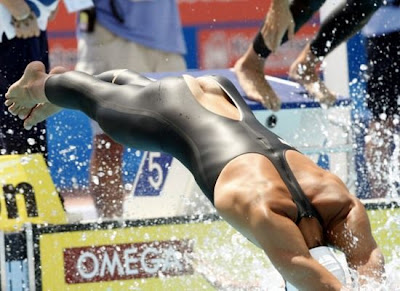
US Swimmer and Beijing relay gold medalist Ricky Berens tore the back of his swimsuit in a qualifying heat of the 4x100m relay freestyle on Sunday during the World Swimming Championships in Rome. Shortly before stepping up to the starting block, the University of Texas senior leaned down to stretch and his suit tore.
"I kind of freaked out for just a second," Berens said. "I felt like [the hole] was almost down to my knees. I felt like I was putting on a pretty good show."
He did. And the US qualified for finals and won.
You try hauling this petard!
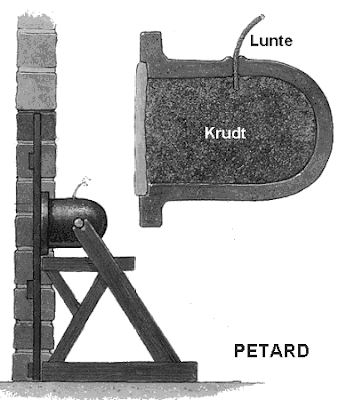
Have you any idea how many times the thesaurus, the dictionary, the etymological expert -- have saved me? The ant's forefoot, again. Have you forgotten? Did you never know?
When the mind swings by a grass-blade
an ant's forefoot shall save you
the clover leaf smells and tastes as its flower.
--from LXXXIII, Pisan Cantos
And so, as I sink into real despair, before I am too low to care I search all there is to know about haul, and then muck around in its vivaciousness. Vivacity? (I remember the words my last French students claimed to enjoy saying -- that is, the words whose actual mouth-feel was pleasing to them: vraisembablement, multicolore -- these two were the top choices for partying in the bouche.)
You can haul someone on the carpet. You can haul them in. Over a long or a short haul, you can haul someone over the coals, though most of us prefer to rake. You can haul off and hit someone... but then you'd better haul ass. When you're lounging in the muck of self-pity, you'd best haul yourself up by your own bootstraps.
The 2006 Oxford Companion to Ships and the Sea -- to what is not the Oxford a companion, and from whom comes its dictate to be companion to the world? -- says this about the transitive verb to haul:
the seaman's word meaning to pull. Virtually every rope that needs a pullHoist is probably richer.
to perform its function is hauled at sea, never pulled. ‘Mainsail-haul’, the
order given in a square-rigged ship to haul round the after yards when it is
nearly head to wind when tacking. A ship also hauls its wind when it is brought
nearer to the wind after running free.
With hoist, I get to use petard.
Of course, hoist with one's own petard has always begged the question of who else's petard would one dare hoist?
Over at the Phrase Finder, I discover a meaning that is unfamiliar: Injured by the device that you intended to use to injure others. Gary goes on to clarify:
The phrase 'hoist with one's own petar[d]' is often cited as 'hoist by one's own petar[d]'. The two forms mean the same, although the former is strictly a more accurate version of the original source. A petard is, or rather was, as they
have long since fallen out of use, a small engine of war used to blow breaches
in gates or walls. They were originally metallic and bell-shaped but later
cubical wooden boxes. Whatever the shape, the significant feature was that they
were full of gunpowder - basically what we would now call a bomb.
The device was used by the military forces of all the major European fighting
nations by the 16th century. In French and English - petar or petard, and in
Spanish and Italian - petardo.
The dictionary maker John Florio defined them like this in 1598:
"Petardo - a squib or petard of gun powder vsed to burst vp gates or doores with."
The French have the word 'péter' - to fart, which it's hard to imagine is unrelated.
Petar was part of the everyday language around that time, as in this rather colourful line from Zackary Coke in his work Logick, 1654:
"The prayers of the Saints ascending with you, will Petarr your entrances through heavens Portcullis".
Once the word is known, 'hoist by your own petard' is easy to fathom.
It's nice also to have a definitive source - no less than Shakespeare, who gives
the line to Hamlet (1603):
"For tis the sport to have the enginer Hoist
with his owne petar".
Note: engineers were originally constructors of military engines.
All this time, I thought the hoist of the petard to be the equivalent of the haul on the bootstraps.
The wonderful thing about the tiny ant's tiny forefeet? They are so small as to not even participate in the ignorance that is bliss. It's a good thing, too, since I am so obsessed with minutia.
Sometimes A Sister Needs A Brother Needs A God (II)


There are ghosts out in the rain tonight/High up in those ancient trees/Lord, I've given up without a fight/Another blind fool on his knees/And all the Gods that I've abandoned/Begin to speak in simple tongues/Lord, suddenly I've come to know/There are no roads left to run/Now it's the hour of dogs a-barking/That's what the old ones used to say/It's first light or it's sundown/Before the children cease their play/When the mountains glow like mission wine/And turn grey like a Spanish roan/Ten thousand eyes will stop to worship/And turn away and head on home/She is reaching out her arms tonight/Lord, my poverty is real/I pray roses shall rain down on me/From Guadalupe on her hill/But who am I to doubt these mysteries/Cured in centuries of blood and candle smoke/I am the least of all your pilgrims here/I am most in need of hope/She appeared to Juan Diego/She left her image on his cape/Five hundred years of sorrow/Have not destroyed their deepest faith/But here I am your ragged disbeliever/Old doubting Thomas drowns in tears/As I watched your church sink through the earth/Like a heart worn down through fear/She is reaching out her arms tonight/Lord, my poverty is real/I pray roses shall rain down on me/From Guadalupe on her hill/But who am I to doubt these mysteries/Cured in centuries of blood and candle smoke/I am the least of all your pilgrims here/But I am most in need of hope/I am the least of all your pilgrims here/But I am most in need of hope
--Tom Russell, Guadelupe
tumbleweed, tumbleweed, my
love, my love, the need,
the need, fits
like the glove.
Wednesday, July 29, 2009
Asystole
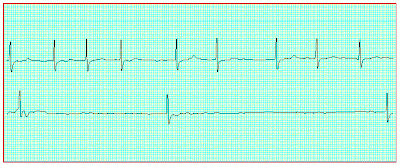
In April, you raised my premium to $1,327.00 (from $1073.00). That caused many a sleepless night, let me tell you!
And so it is completely in keeping with your absence of soul and your insatiable greed, that you should raise my premium once again, this time to $1,513.00 -- beginning in October.
YOU WIN.
I am, as I type this, falling through the cracks. I cannot pay that amount. When I called to see if there were any options left me? Oh, the Hem-and-the-Haw of it all! I could apply for cheaper coverage, opined the Customer Care Associate... but acceptance will be based on my medical history.
Given that it took the Office of the Governor to get *this* shitty coverage, I don't think BCBS of Tête de Hergé is going to offer me anything else out of the kindness of its corporate heart.
Good luck to the rest of you.
Dear President Obama,
It looks like too little, too late...
Tuesday, July 28, 2009
Great Performances: Pete Seeger Does 90

Creating the Next Generation of Environmental Leaders
A benefit concert in celebration of
Pete Seeger's 90th Birthday
Featuring....
Pete Seeger
Tom Morello (Rage Against the Machine)
Bruce Springsteen
Tyler Ramsey (Band of Horses)
Dave Matthews
Warren Haynes
John Mellencamp
Abigail Washburn & the Sparrow Quartet
Ani DiFranco
Bernice Johnson Reagon
Arlo Guthrie
Dar Williams
Béla Fleck
Eric Weissberg
Ben Bridwell (Band of Horses)
Guy Davis
Ben Harper
Jay Ungar & Molly Mason
Billy Bragg
John Hall
Bill Nershi (String Cheese Incident)
Kate & Anna McGarrigle
Bruce Cockburn
Larry Long
Del McCoury
Martha Wainwright
Emmylou Harris
Mike & Ruthy Merenda
Joan Baez
NYC Labor Chorus
Keller Williams
Ruby Dee
Kris Kristofferson
Scarlett Lee Moore
Michael Franti
Tao Rodriguez-Seeger
Patterson Hood (Drive-By Truckers)
Teddy Thompson
Preservation Hall Jazz Band
Tom Chapin
Ramblin' Jack Elliott
Tom Paxton
Richie Havens
Tommy Sands with Moya & Fionan
Roger McGuinn
Tony Trischka
Steve Earle
Toshi Reagon
Taj Mahal
And the Native American Indian Cultural Alliance...
Bill Miller
Margo Thunderbird
Casper Lomadawa
Oren Lyons
David Amram
R. Carlos Nakai
Eddie Benton
Tiokasin Ghosthorse
Joseph Firecrow
Vernon Masayesva
Joanne Shenandoah
Victorio Roland Mousaa
All proceeds to benefit the Hudson River Sloop Clearwater (www.clearwater.org),
a non-profit organization created to defend and restore the Hudson River.
For more information, visit: www.clearwater.org.
**** **** **** **** **** **** ****
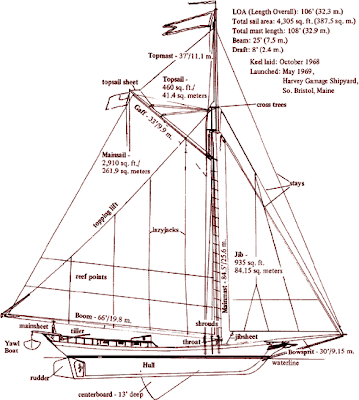
SAILING DOWN MY GOLDEN RIVER
Sailing down my golden river,
Sun and water all my own,
Yet I was never alone.
Sun and water, old life givers,
I'll have them where e'er I roam,
And I was not far from home.
Sunlight glancing on the water,
Life and death are all my own,
Yet I was never alone.
Life to raise my sons and daughters,
Golden sparkles in the foam,
And I was not far from home.
Sailing down this winding highway,
Travelers from near and far,
Yet I was never alone.
Exploring all the little by-ways,
Sighting all the distant stars,
And I was not far from home.
-- Words & music by Pete Seeger, 1971,
in support of his work with the sloop
Clearwater on the Hudson River.
By FRAZIER MOORE (AP)
NEW YORK — Pete Seeger has never paid attention to demographics or audience segments. His message has always been about inconclusiveness as a performer.
And he's a performer in many senses of the word.
"A musician, singer, songwriter, folklorist, labor activist, environmentalist, peace advocate," listed Tim Robbins at the start of an all-star gathering at Madison Square Garden last May to celebrate Seeger's 90th birthday.
This celebration has been captured as a "Great Performances" special, and it's full of passion and ideals, nostalgia for past gains and hope for the future. (It premieres this week, airing individually on PBS stations over the next few weeks; check local listings for date and time.)
Joining Seeger are more than 40 artists...
Collectively, they sing of a joyous activism and love of country. At the same time, they help shed a little light (for those of us who need it) on Seeger's remarkable impact.
The gathered talent invites the audience to join in singing "We Shall Overcome," while reminding us that it was Seeger who helped convey it from a labor song to a signal civil rights anthem.
"Turn! Turn! Turn! (to Everything There Is a Season)," a signature hit for the Byrds 40 years ago, was written by Seeger (in collaboration with the Bible), and former Byrds member McGuinn is on hand to perform it as if it had been recorded yesterday.
Mellencamp sings "If I Had a Hammer (the Hammer Song)," a peace song so immersed in the culture it's hard to believe Seeger could have written it at the dawn of the militaristic 1950s Red Scare.
The concert was a benefit for the Hudson River Sloop Clearwater, an organization Seeger started to preserve and protect the Hudson River and other natural resources. Indeed, the beautifully staged concert (and TV version) takes place on the "deck" of a "boat," with strings of lights tracing its mast and sails that rise to the rafters of the Garden. This is a vivid representation of the organization's own vessel, the gaff sloop Clearwater.
The Clearwater and its mission of conservation also inspire a song "Sailin' Up, Sailin' Down," which declares, "The river may be dirty now, but it's gettin' cleaner every day."
Baez sings "Where Have All the Flowers Gone?"
Havens serves up his powerful "Freedom."
And though he doesn't sing onstage much anymore, Seeger does what he's been doing as long as he's been singing: Leads others in song. Wiry and ruddy-faced in his jeans, cap and bright flannel work shirt, he urges the audience to take part in "Amazing Grace," heartily assuring one and all, "There's no such thing as a wrong note, as long as you're singing."
The concert ends on a high note with another rousing singalong: "This Land Is Your Land."
That's shortly after Springsteen steps on stage to perform "The Ghost of Tom Joad" in duet with Morello, the former Rage Against the Machine and Audioslave guitarist.
During his spot, it's Springsteen who perhaps best puts Seeger in perspective: "a walking, singing reminder of all of America's history ... a testament of the power of song to nudge history along."
Then, with amused admiration, he adds, "Despite Pete's somewhat benign grandfatherly appearance, he is a creature of a stubborn, defiant and nasty optimism." That makes Springsteen chuckle. "And it won't let him take a step back from the things he believes in."
This concert special is convincing evidence. Seeger sails on, like the song says, "catchin' fish and catchin' hell," in his 91st defiant, optimistic year.
On the Net:
CRPS Clinical Trials

I haven't posted an update of open CRPS clinical trials in a good while. Sorry about that, and allow me to make rapid amends:
1. Autonomic Dysfunction and Spinal Cord Stimulation in Complex Regional Pain Syndrome (CRPS) Vanderbilt University
To demonstrate that spinal cord stimulator has an effect on sympathetic function (the one that give us the fight and flight response). Therefore, if the spinal cord stimulator has an effect on sympathetic function, the responses from CRPS patients to different stimuli will differ significantly pre and post SCS implant. If CRPS patients exhibit autonomic, CRPS patients could be stratified according to their sympathetic function pre-implant. It is expected that patients with a moderate/mild form of autonomic dysfunction will have better outcomes with the SCS.
2. Effect of Delta-9-Tetrahydrocannabinol on the Prevention of Chronic Pain in Patients With Acute CRPS (ETIC-Study) Study at University of Munich.
3. Safety and Efficacy Study of Ethosuximide for the Treatment of Complex Regional Pain Syndrome (CRPS). Pain remains the most debilitating symptom for adult patients suffering from complex regional pain syndrome (CRPS). Most CRPS patients gain little to no relief from current painkillers. The purpose of this study is to evaluate the efficacy and safety of ethosuximide in search of much-needed adjunctive therapy to relieve the pain and suffering associated with CRPS. Study at McGill University, Canada.
4. Graded Exposure (GEXP) in Vivo Versus Physiotherapy in Complex Regional Pain Syndrome Type I (CRPS-I) THIS STUDY IS NOT *YET* OPEN -- Maastricht University Medical Center in the Netherlands
5. Double Blind Placebo Controlled Study of Outpatient Intravenous Ketamine for the Treatment of CRPS Complex Regional Pain Syndrome is a debilitating and extremely difficult to treat condition. There is a large body of evidence demonstrating the therapeutic value of N-methyl-D-aspartate (NMDA)-receptor antagonists in CRPS. The NMDA antagonist ketamine has been shown to be effective in the treatment of CRPS, resulting in complete remission of the disease in some patients. The purpose of this study is to evaluate intravenous outpatient infusion of sub-anesthetic doses of ketamine for the treatment of CRPS. A thorough evaluation of this procedure, providing information into the degree of relief and which of the constellation of RSD symptoms are best alleviated by this procedure would result in the optimization of this therapy for the treatment of CRPS. Responsible Party: Drexel University College of Medicine (Dr. Robert J. Schwartzman, MD)
6. Pain Exposure Physical Therapy (PEPT) Versus CBO in Patients With Complex Regional Pain Syndrome Type I (CRPS-1) (PEPTOC) THIS STUDY IS NOT *YET* OPEN. Radboud Univ. in the Netherlands
7. Association Between Focal Dystonia and Complex Regional Pain Syndrome an NIH study:
This study will investigate differences among people with focal dystonia (FD), complex regional pain syndrome (CRPS) and people who have both conditions to learn more about the cause of both disorders. Participants undergo the following procedures in five visits:
Electroencephalography (EEG). Electrodes (metal discs) are placed on the scalp with an electrode cap, a paste or a glue-like substance. The spaces between the electrodes and the scalp are filled with a gel that conducts electrical activity. Brain waves are recorded while the subject lies quietly and sensory stimulation is applied to the thumb or finger.
Magnetic resonance imaging (MRI). This test uses a magnetic field and radio waves to obtain images of body tissues and organs. The patient lies on a table that can slide in and out of the scanner, wearing earplugs to muffle loud knocking and thumping sounds that occur during the scanning process. The procedure lasts about 45 minutes, during which time the patient will be asked to lie still for up to 15 minutes at a time.
Transcranial magnetic stimulation (TMS). An insulated wire coil is placed on the scalp and a brief electrical current is passed through the coil. The current induces a magnetic field that stimulates the brain. There may be a pulling sensation on the skin under the coil and a twitch in muscles of the face, arm or leg. During the stimulation, subjects may be asked to keep their hands relaxed or to contract certain muscles.
Peripheral electrical stimulation. In two experiments, TMS is combined with peripheral electrical stimulation, similar to what is used in nerve conduction studies, to the median nerve at the wrist. There may be muscle twitching.
Surface electromyography. For TMS tests and peripheral electrical stimulation, electrodes are filled with a conductive gel and taped to the skin to record the electrical activity of three muscles on the right hand.
Needle EMG. A needle is inserted into a muscle to record the electrical activity.
Nerve conduction studies. A probe is placed on the skin to deliver a small electrical stimulus, and wires are taped to the skin record the nerve impulses. These studies measure the speed with which nerves conduct electrical impulses and the strength of the connection between the nerve and the muscles.
Skin biopsy. Two sites are biopsied. A local anesthetic is given to numb the area and a 1/4-inch piece of skin is removed with a special tool.
JVP domes. Subjects are tested for their ability to discriminate sensory stimuli in the affected region and on the other side of it. They are asked to discriminate between stamps with grooves of different widths that are applied to the hands or feet.
8. The Effect of Transcranial Direct Current Stimulation (t-DCS) On the P300 Component of Event-Related Potentials in Patients With Chronic Neuropathic Pain Due To CRPS or Diabetic Neuropathy This study is not yet open for participant recruitment. Soroka University Medical Center in Beersheba, Israel
9. A Study of the Effect of Lenalidomide on Complex Regional Pain Syndrome Type 1
Mayo Clinic -- Rochester, Minnesota
More on Lenalidomide here.
10. Evoked Fields After Median and Ulnar Stimulation
Medical Center Alkmaar
Rudolf Magnus Institute – University of Utrecht
Technical University of Twente
VU University of Amsterdam
Dept. of Clinical Neurophysiology - VU University Hospital Amsterdam
Human Brain Mapping and Cortical Imaging Laboratory, Centre for Sensory – Motor Interaction, Aalborg University
Intervention = Evoked fields before and after a local block (Xylocaine)
11. Pregabalin Versus Placebo as an Add on for Complex Regional Pain Syndrome (CPRS) of the Upper Limb Managed by Stellate Ganglion Block (The PREGA Study)
McMaster University, Ontario, Canada
12. The Efficacy of Motor Cortex Stimulation for Pain Control
The objective is to determine if motor cortex stimulation works for the following conditions:
Deafferentation facial pain,
Upper extremity complex regional pain syndrome (CRPS) and
Brachial plexus avulsion or phantom limb pain.
Each of these groups of 6 patients (total of 18) will be studied independently and all patients will be implanted with a motor cortex stimulation system.
13. Neurotropin to Treat Chronic Neuropathic Pain An NINR study, Bethesda, Maryland
14. Evaluation and Diagnosis of People With Pain and Fatigue Syndromes
An NINR study; No treatment is offered under this protocol.
15. Regional Anesthesia Military Battlefield Pain Outcomes Study (RAMBPOS)
The purpose of this study is to examine the short and long-term benefits of implementing early advanced regional anesthesia techniques for pain control, such as reducing pain disability and the incidence and severity of mental health disorders, following major traumatic injuries to extremities encountered during combat in the Iraqi/Afghanistan war. Dept. of Veterans Affairs/Walter Reed
16. Susceptibility to Chronic Post-Traumatic Extremity Pain The association between the COMT haplotypes and the presence or absence of CPSP or CRPS will be assessed stratifying the patients based on the individual categories of trauma or elective surgery. William Beaumont Hospitals, Michigan
17. N/A Cardiac Rehabilitation Programs = (CRPs)!
18. N/A
19. Cerebrospinal Fluid Repository (CSF) The purpose of a CSF repository is to collect samples of spinal fluid from controls and patients with neurologic disorders including but not exclusively ALS, Dementia, CRPS, neuropathies, and other neuromuscular diseases. This CSF repository will allow the use of CSF in biochemical studies of various neurologic diseases. It would also provide a supply of the necessary normal and disease control patients. CSF would be obtained from patients who are undergoing spinal taps for other reasons including diagnosis, treatment, or participation in clinical trials. We are proposing to collect an additional <>
Leontina

She did share that her feet hurt.
We covered a wide variety of topics: the deleterious effect of celebrities who off themselves by misuse of pain medication (or, rather, in her estimation -- ill-advised combinations of drugs); the evil Dr. Scott Reuben and his own deleterious effect on the world of pain medicine; my particular situation (she used to work for my orthopedic surgeon); the price of Zyvox and tea in China.
Super shoes. Prescriptions for methadone, percocet, tizanidine, and amitriptyline. Could life get any better? [Shut. Up. I. Am. Being. Ironic. Sardonic. All. Kinds. Of. -Ics.]
I have worked out an effective pain management regimen, about which I keep her and Dr. PainDude informed. It's a combination of pharmaceuticals -- and that means as little drug as possible -- and distraction -- but mostly? Lately, I have resorted to heavy doses of meditation and basic relaxation techniques. It has caused some unrest here at Marlinspike Hall, deep, deep in the Tête de Hergé, as Fred, La Bonne et Belle Bianca Castafiore (a sister shoe freak), and the Four Felines all feel "cut off," deprived of my affection and attention.
Still, the pain is pretty bad. It hits me in those periods when I'm not covered by my "regimen." Like right now -- I need to take breakthrough pain meds, do some pendulum swings, work on my legs (a whole other post), and take a mental ax to the anxiety surging through my body at the thought of what the surgeon may propose. If forced to resort to the dreaded Pain Scale, I am at a 7.
And out of time! Think good thoughts -- think "no surgery--no surgery--no surgery--no surgery--no surgery." Cross the applicable digits.
[Thanks!]
